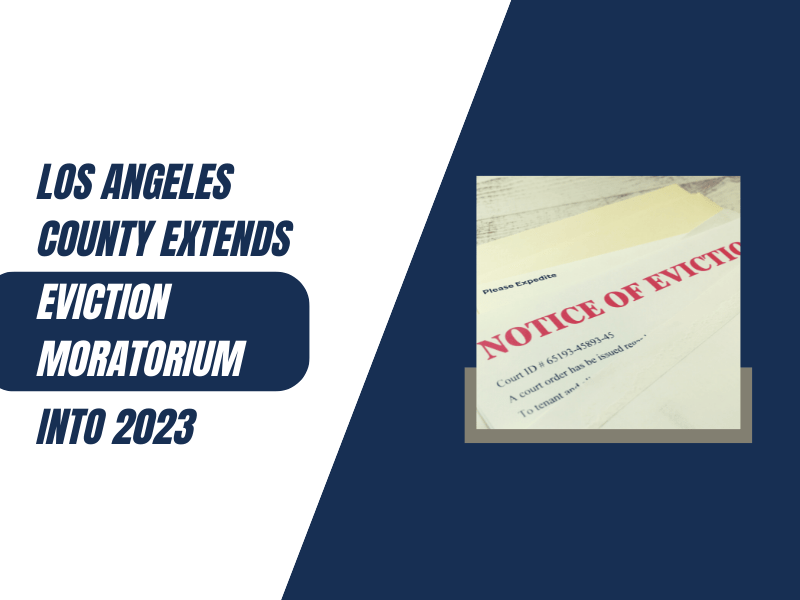You might have thought that the eviction moratorium associated with the COVID-19 pandemic ended across California in the spring of 2022.
It did, and it didn’t.
In Los Angeles County, some renters still have protections against eviction, and the moratorium has been extended into 2023, with three diminishing phases that will ultimately end it, but continue to support the tenants who are not able to catch up completely with their rental payments.
Unless it’s extended again, the last phase of the eviction moratorium in Los Angeles County will end on June 30, 2023.
Which Rental Properties are Subject to this Moratorium?
The first question you may be asking is whether your property is subject to the continuation of the eviction moratorium. Here’s what you need to know.
The Los Angeles County eviction moratorium was recently extended to all rental properties both within unincorporated areas of the County and any incorporated areas that are under less restrictive or no COVID-related tenant protections.
This ban on evictions is different from the freeze on rent increases. The freeze on rent increases applies only to rental properties within the unincorporated areas of Los Angeles County that find themselves under the County’s Rent Stabilization ordinance.
Eviction Moratorium Phases in Los Angeles County
Initially, the eviction moratorium broke out into two phases. Los Angeles County’s COVID-19 Tenant Protections Resolution (formerly the LA County Eviction Moratorium), went into effect March 4, 2020. It provided a set of protections to residential tenants who were affected by the COVID-19 pandemic in Los Angeles County and found themselves unable to pay rent.
On January 25, 2022, the Los Angeles County Board of Supervisors voted to extend the COVID-19 Tenant Protections Resolution through December 31, 2022, and recently it was further extended into 2023 and a third phase by the Board.
These are how the phases look:
Phase 1
Phase 1 began on February 1, 2022, and extended until May 31, 2022. Phase 1 included:
A rent freeze
A prohibition on evictions deemed “no-fault” evictions (except if an owner wants to move into a single-family home, duplex or triplex, but ONLY IF the property was purchased prior to June 2021. As you likely understand, a no-fault eviction is when a tenant has not violated their lease agreement or stopped paying rent, but the owner still wants to remove the tenant from the property in order to manage a remodel or renovation, to live in the home themselves, or to do something else entirely with the property.
A prohibition on nuisance evictions, which is done when a tenant is disturbing the quality of life of other residents or for refusing to allow an owner to enter a unit for repairs or emergencies.
A prohibition on evictions due to tenants allowing extra occupants or pets to move into the home. This may violate a lease agreement, but the eviction moratorium supersedes the lease.
This is also part of Phase 1: Beginning on April 1, 2022, owners were not able to evict for nonpayment of rent. Tenants were simply required to self-certify that they were impacted by COVID-19 and could not pay rent. There was no proof required.
Phase 2
Phase 2 of the eviction moratorium began on June 1, 2022, and is set to expire on December 31, 2022. This includes a continued ban on rent increases and evictions. It basically mirrors Phase 1 of the program, but with a couple of key exceptions.
There’s no longer a requirement that the property had to be purchased on or before June 30, 2021. Owners are now able to move into their properties and evict their tenants as long as they own three units or less.
Eviction protections for nonpayment of rent only apply to tenants who are making 80 percent of the Area Median Income (AMI) or less.
Eviction protections are still in place for nuisance lease violations and unauthorized occupants and pets. Qualified renters are still protected against eviction as well.
In Phase 2, you can evict a tenant who does not allow you to access the property. The only defense they would have is to claim harassment. If you’re not harassing your tenant, however, and you need to get inside the property to ensure there’s not a maintenance emergency or a hoarding situation or a problem that could jeopardize safety and habitability, you can take steps towards eviction for the protection of your unit and the tenants.
During Phase 2, there is still no rental increase permitted under the Rent Stabilization Ordinance in Los Angeles County.
Phase 3
The most recent phase of the eviction moratorium in Los Angeles County begins on January 1, 2023, and ends on June 30, 2023. Here’s what it means for owners and tenants:
Only protections for tenants who cannot pay rent will remain in place for those residents who are at or below the 80 percent AMI. However, the Board could decide to add additional protections at a later time.
What Does this Mean for Your Los Angeles County Rental?
Most of the properties and the tenants we work with are more or less back to normal in terms of rental payments, lease enforcements, and evictions. If you’re still working with a tenant who has certified that they are impacted financially by COVID-19 and still cannot make the rental payments, you’ll first want to make sure they meet the criteria necessary to seek eviction protections. If they do, you must follow the moratorium that’s in place for those renters. If they earn enough not to be protected, you should still talk to a Los Angeles property manager or an experienced attorney before moving forward with an eviction action.
It’s not always easy to stay up to date on California’s tenant protections and legal requirements. In Los Angeles County, there are ever-evolving protections as well, and they’re often different from the City of Los Angeles.
 We’d be happy to help you make sense of what this means now and in the future for your Los Angeles County rental property. Please don’t hesitate to reach out to us at Bell Properties.
We’d be happy to help you make sense of what this means now and in the future for your Los Angeles County rental property. Please don’t hesitate to reach out to us at Bell Properties.
Los Angeles County Given Until December 1st to Modify or Abandon Eviction Moratorium
Federal District Court Judge’s Order Granting Motion for Preliminary Injunction Cites Rampant Disparities and Ambiguities Within L.A. County Ordinance and Concludes the County’s “Tenant Protections are Unconstitutionally Vague”
The Apartment Owners Association of California, Inc. (AOA) and the Apartment Association of Greater Los Angeles (AAGLA) jointly announced today that they have been granted a preliminary injunction they had been seeking to prevent enforcement of Los Angeles County’s broad-based moratorium on residential tenant evictions. In the United States District Court judge’s order granting the landlord group’s motion for preliminary injunction, multiple violations of the “Vagueness Doctrine” and the complete lack of specific standards for how to apply various provisions contained within the County’s eviction moratorium are cited. The District Court judge’s order concludes that “Plaintiffs are likely to succeed on the merits of their claim that the Resolution’s Tenant Protections are unconstitutionally vague.”
The District Court has given Los Angeles County until December 1st to modify the eviction moratorium, and to give owners and tenants a chance to adjust, at which time it will no longer be able to enforce its eviction moratorium ordinance. According to the Order: “Effective December 1, 2022, the County is hereby enjoined from enforcing the Tenant Protections…”
In March 2022, AOA and AAGLA had filed a joint lawsuit in Los Angeles County Superior Court for the State of California on behalf of their members and the County’s rental housing providers seeking, among other relief, an Injunction against the enforcement of the County of Los Angeles’s residential eviction moratorium. Los Angeles County’s so-called, “temporary” eviction moratorium has remained in place nearly three years, and is set to expire on December 31, 2022. The County’s COVID-19 eviction protections cover not only the County’s unincorporated areas, but also most of the incorporated cities within the County.
Los Angeles City Eviction Moratorium Updates (October 2022)
On October 4, 2022, the Los Angeles city council voted to wind down the eviction moratorium that has been in place since March 2020, making it one of the longest COVID tenant protections in the country. Pending a final ordinance, non-payment of rent [unlawful detainer] cases will be allowed to resume in February 2023. It is important to note that this will apply to tenants who do not pay their rent from February 2023 and beyond. Tenants who owe rent prior to February 2023 will get extra time to pay back that rent and landlords will not be allowed to evict tenants for that rent until a later date. The bottom line is, if a tenant fails to pay the rent in February 2023, landlords will be able to use that non-payment as a reason to evict, but landlords may not be able to include on a 3-day notice to pay rent or quit rent that became due prior to February 2023.
No-fault evictions may finally be allowed beginning in February 2023, subject to [the City’s Rent Stabilization Ordinance] RSO rules and any new rules that the city council implements.
Rent increases for RSO buildings will be allowed beginning in February 2024. (Rent increases in non-RSO buildings are already allowed, subject to other laws.) Tenants will also be able to be evicted for unauthorized occupants and unauthorized pets in February 2024, and only after the landlord has provided a 30-day notice for the tenant to remedy the situation (this goes beyond California law, which requires a 3-day notice for such cases). Yes, you read the year correctly: “2024.”
Housing providers, beware: the city council is also discussing adding tenant protections that would apply to properties that have historically been exempt from City’s RSO. Among other things, these proposed new tenant protections could impose strict roadblocks to no-fault evictions.


